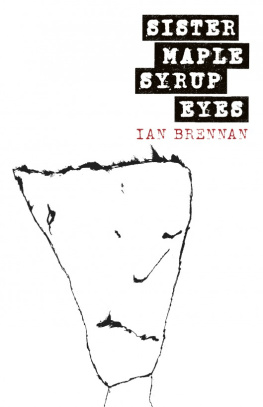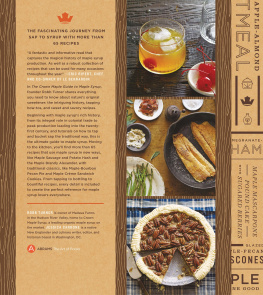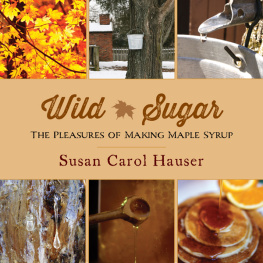The Sugar Season
ALSO BY DOUGLAS WHYNOTT
A Country Practice: Scenes from the Veterinary Life
A Unit of Water, a Unit of Time: Joel Whites Last Boat
Giant Bluefin
Following the Bloom: Across America with the Migratory Beekeepers


Copyright 2014 by Douglas Whynott
All rights reserved. No part of this publication may be reproduced, stored in a retrieval system, or transmitted, in any form or by any means, electronic, mechanical, photocopying, recording, or otherwise, without the prior written permission of the publisher. For information, address Da Capo Press, 44 Farnsworth Street, Third Floor, Boston, MA 02210.
Editorial production by Marrathon Production Services.
www.marrathon.net
Book design by Jane Raese
Set in 10-point Linoletter
Library of Congress Cataloging-in-Publication Data is available for this book.
ISBN 978-0-306-82205-6 (e-book)
Published by Da Capo Press
A Member of the Perseus Books Group
www.dacapopress.com
Da Capo Press books are available at special discounts for bulk purchases in the U.S. by corporations, institutions, and other organizations. For more information, please contact the Special Markets Department at the Perseus Books Group, 2300 Chestnut Street, Suite 200, Philadelphia, PA 19103, or call (800) 810-4145, ext. 5000, or e-mail .
10 9 8 7 6 5 4 3 2 1
FOR JAY NEUGEBOREN
CONTENTS

Am I not a sugar maple man, then? Boil down the sweet sap which the spring causes to flow within you. Stop not at syrupgo on to sugar, though you present the world with but a single crystal.
Henry David Thoreau
It is certain that every farmer having one hundred acres of sugar maple land, in a state of ordinary American improvement (that is, one third covered with judicious reserves of wood and timber, and two thirds cleared for the culture of grass and grain), can make one thousand pounds of sugar with only his necessary farming and kitchen utensils, if his family consists of a man, a woman and a child of ten years, including himself.
Coxe Turner, 1794, from Helen and Scott Nearing, The Maple Sugar Book


T HOUGH IT WAS JANUARY and well ahead of the time when sap normally runs in the maple trees in New Hampshire and Vermont, the weather was warm and the trees were beginning to stir. When I was in Boston during that last week of January in 2012 the temperature was 54. Students were wearing T-shirts on the Boston Common, and a friend told me that when she had some trees cut in her yard, the sap was running. I knew I had to get over to Bascoms to see if it was running there.
Some meteorologists were saying there had been three Novembers, starting with the one in November, followed by two more in December and January. The fall of 2011 in the northeastern United States had been one of the warmest in in history, and January was the tenth consecutive month with above-normal temperatures. There were surprising temperature readings throughout the North, such as in Minot, North Dakota, where the temperature got up to 61 on January 5.
The question, of course, was whether February would be a fourth November. This seemed possible on February 1, when a heat wave passed through the Northeast and temperatures got into the sixties. The cause was two opposing weather fronts, one spinning clockwise to the west and a Bermuda front off the coast spinning counterclockwise, working together like paddle wheels to pull up a current of warm air from the south. The heat brought on a thaw and awakened maple trees, causing the earliest sap flow that all the maple syrup producers I talked to had ever experienced. Those who tapped their trees early enough got their first maple syrup crop of the 2012 sugar season.
I went to Bascoms Maple Farm on February 1. I drove up a hill called Sugar House Road, passing by a row of ancient maple trees that line that road next to a hay field, next to lines of tubing in the woods and the house that Ken Bascom built and that Bruce Bascom grew up in. I came to a stop in the parking lot in front of the sugarhouse. Bascoms was a quiet place now, and nothing like it would be in a few weeksor maybe soonerwhen steam would be blasting up through the roof in a column four feet wide and the scent of maple would fill the air.
Anyone going to that place experiences the soul-stirring views. Bascoms stands near the top of a landform called Mount Kingsbury, in Acworth, New Hampshire. They are 1400 feet above sea level, not all that high up compared to other mountains, but the perch is quite high relative to the surrounding landscape. The Connecticut River, four miles to the west, is 200 feet above sea level, and so from Mount Kingsbury and where Bascoms stands are views of fifty miles, halfway across Vermont to the Green Mountains, to some of the ski slopes and as far as Mount Greylock in Massachusetts. Someone who worked for Bruce Bascom said that Bruce had never left this mountain, which was both true and untrue. Bruce left it many times, but you could say his heart never left it, and he had set out after college to save this farm and had once said to me, Why should I go anywhere when I can be here? He also said, I have seen a lot of sugarhouses, and I think this one is the best.
Sugarhouses are located in some of the most beautiful places. They sit by groves of maple trees, sugar orchards some people call them or, more commonly, sugarbushes. Maples are among the most magnificent trees on earth, in a plant form long known as the giver of life. We know this ever so truly now, in that trees extract carbon from the air and produce oxygen. I, for one, love to go into the forest and breathe the cool oxygenated air. Maple trees process carbon during photosynthesis, making carbohydrates that they later convert to sugar when the warm weather comes and the sap begins to flow. The wood of the sugar maple, also called rock maple, is extremely hard and produces those striations called birds eye maple and tiger maple. During the time when the sap runs, the maple tree produces gas internally, which pressurizes the tree and aids in the sap flowthe maple is one of those rare trees that have air inside. And maple trees produce that soft green light in the summer season. Of course they most famously blaze spectacularly in the fall. Sugarhouses are there, by these places, by these trees. Sugarhouses help define those landscapes and the cultures built around them.
In the minds of most people, those who know something about maple syrup and its production, a sugarhouse is a cottage-sized building with a smokestack for a wood fire and a cupola or some other sort of opening for venting steam. The sugarhouse sits alongside a road, maybe an unpaved country road. There is a woodpile outside and maybe buckets hanging on trees nearby. Possibly there is a horse, maybe a draft horse used to pull a wagon and gather maple sap. Snow covers the ground, a fire is burning, and the sugarhouse door is open. There is syrup ready to be sampled.
Next page









